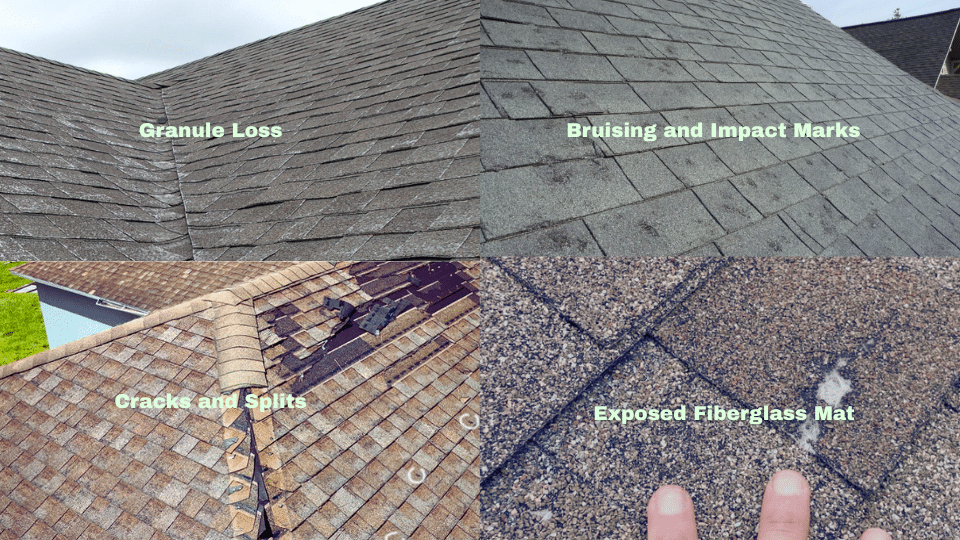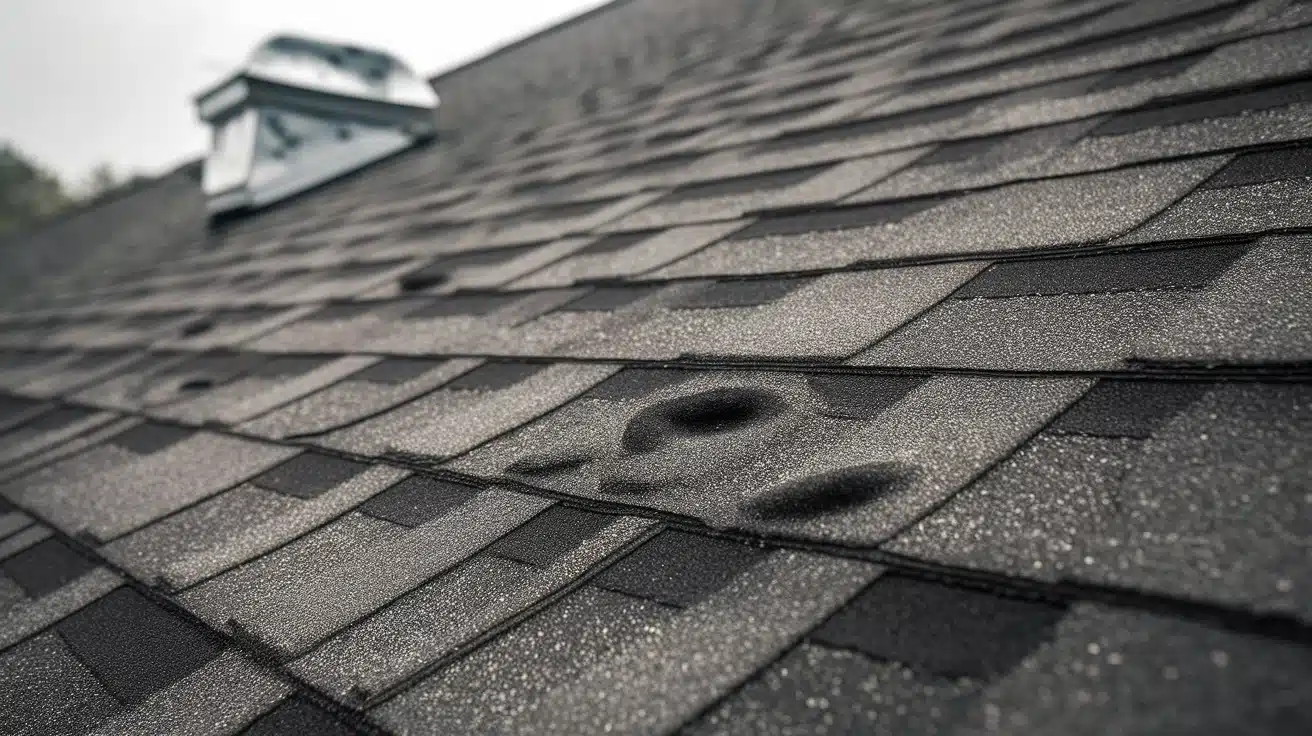Hailstorms strike many areas at least once a year, often bringing stones between 1 to 4 inches in size.
These icy impacts can cause serious damage to roofs, vehicles, and landscaping, even if the signs aren’t always easy to spot. After the storm clears, many homeowners are left wondering how to tell if their roof has been affected.
The trouble is, minor dents and missing granules may not look urgent, but they often lead to water leaks and costly repairs down the line.
Here you’ll learn to recognize early damage, check your roof safely from the ground, and understand when it’s time to bring in a professional.
Knowing what to look for is key to avoiding bigger issues later and keeping your home protected.
Factors That Influence Hail Roof Damage
The appearance of a roof depends on several key factors; understanding these helps you assess the severity of your situation after a storm.
The size of hailstones, wind conditions, and the type of roof material all play important roles in determining damage patterns.
Knowing these factors helps you better understand what to expect and communicate with insurance adjusters.
Hailstone Size Impact Chart
| Hail Size | Comparison Object | Damage Description |
|---|---|---|
| 1 inch | Quarter | Little to no exterior damage may dislodge granules from shingles |
| 1.25 inch | Half Dollar | Minor damage to most roofs, cracks in siding, damage to vinyl and screens |
| 1.50 inch | Ping Pong Ball | Severe roof damage, dents in wood surfaces, clear impact marks on gutters |
| 1.75 inch | Golf Ball | Exterior paint damage, car dents, broken windows, and damaged metal fixtures |
| 2.50 inch | Tennis Ball | Broken car windows, punch holes in roofing, cracks in concrete tiles |
To understand how to spot issues after a storm, it helps to first know what affects the way damage appears.
What Does Hail Damage Look Like on Asphalt Shingles?

Roof storm damage typically manifests in several ways. Most homeowners miss these signs because they’re subtle at first. Minor impacts can seem harmless but cause major problems over time.
Understanding what to look for helps you spot damage before it becomes expensive to fix.
1. Granule Loss
Granules are the small, sand-like pieces on your shingles. When hail hits, it knocks these granules off. Look for dark spots where granules are missing, shiny patches of exposed asphalt, and granules in gutters after a storm.
These tiny pieces protect your roof from sun damage and water, so losing them makes your shingles age faster and fail sooner.
2. Bruising and Impact Marks
Hail creates “bruises” on shingles similar to bruises on fruit. These marks feel soft when you press them, look dark or black in color, have circular shapes from hail impact, and don’t bounce back when touched.
These bruises weaken the shingle material. They allow water to seep through over time.
3. Cracks and Splits
Larger hailstones cause visible cracks in shingles. Look for brown or orange-colored splits, sharp corners and edges, tears that go through the shingle, and impact marks along the cracks.
Fresh cracks from hail look different from age-related damage. They have clean edges and show little wear.
4. Exposed Fiberglass Mat
Severe roofing hail impact can expose the fiberglass mat under the shingles. This appears as white or gray material showing through shiny, reflective areas, spots where the top layer is gone, and visible backing material.
Exposed mats need immediate attention. Water can easily penetrate these areas.
Now that you know the key factors, let’s take a closer look at how roof damage may show up—especially on asphalt shingles.
Tools and Materials for Safe Inspection of the Roof
Identifying the impact of roofing hail on a roof requires the right tools and safe methods. Having proper equipment helps you spot damage without putting yourself at risk.
The right tools make it easier to document damage and communicate with insurance professionals.
Smart preparation keeps you safe while gathering the necessary information.
| Tool Category | Items Needed | Purpose |
|---|---|---|
| Safety Equipment | Binoculars, flashlight, camera | View roof details safely from the ground level |
| Documentation Tools | Measuring tape, claim forms, notebook | Record damage for insurance claims |
| Safety Guidelines | Never climb on the roof without proper equipment | Prevent accidents and injuries |
| Professional Tools | Drone cameras, roof walking gear, and moisture meters | Advanced equipment only experts should use |
WARNING: NEVER attempt roof inspection without proper safety training and equipment. Serious injury or death can occur from falls.
Before you start looking for damage, make sure you have the right tools and follow safe methods to protect yourself.
Signs of Hail Damage from the Ground
You don’t need to climb on your roof to spot roof storm damage. Many signs of a roofing hail impact on a roof can be observedfrom ground level.
These visible clues help you determine if your roof needs professional inspection.
Looking for damage from the ground keeps you safe while giving you important information about potential roof problems.
Professional roofers use this same ground-level approach as their first step before any roof inspection.
Smart homeowners can gather valuable information about storm damage signs without putting themselves at risk.
With tools in hand, here’s how you can safely scan for signs of trouble without stepping onto the roof.
Common Mistakes When Checking for Hail Roof Damage
After a storm, many homeowners try to check for damage on their own. While it’s good to stay alert, a few common mistakes can lead to missed problems or unsafe situations.
- Climbing on the roof without safety gear or proper experience
- Ignoring small dents, soft spots, or missing surface granules
- Assuming the roof is fine just because there are no visible holes
- Overlooking gutters, vents, and downspouts that show a clear impact
- Relying only on a quick glance or single-angle inspection
- Skipping a professional inspection, even when signs seem minor
- Waiting too long to document damage for insurance
- Believing all damage will be evident to the untrained eye
As you inspect, there are a few common missteps to avoid that could lead to missed warning signs or safety risks.
What To Do After Hail Storm Roof Damage?
Once you understand what storm damage looks like on a roof, take these steps to protect your home.
Contact a roofing contractor for a free inspection. Professionals can identify roof storm damage and can spot hidden problems you might miss.
Take photos of all damage for insurance documentation. Record the signs of storm damage on your roof with clear pictures from multiple angles.
Call your insurance company if you find damage indicators. Report the roof damage with your photos as evidence to support your claim.
Conclusion
Roof damage from storms can be easy to miss but costly if ignored. Small dents, surface cracks, or granule loss may not look serious at first, yet they often lead to water leaks and interior issues over time.
Checking from the ground is a safe way to spot early signs, especially when paired with clear photos for insurance.
Avoid walking on the roof and don’t delay professional help if anything looks off.
A trained expert can spot hidden problems and recommend the right repairs.
Think your roof took a hit? Schedule an inspection with a local roofing professional today and take the first step toward protecting your home.








